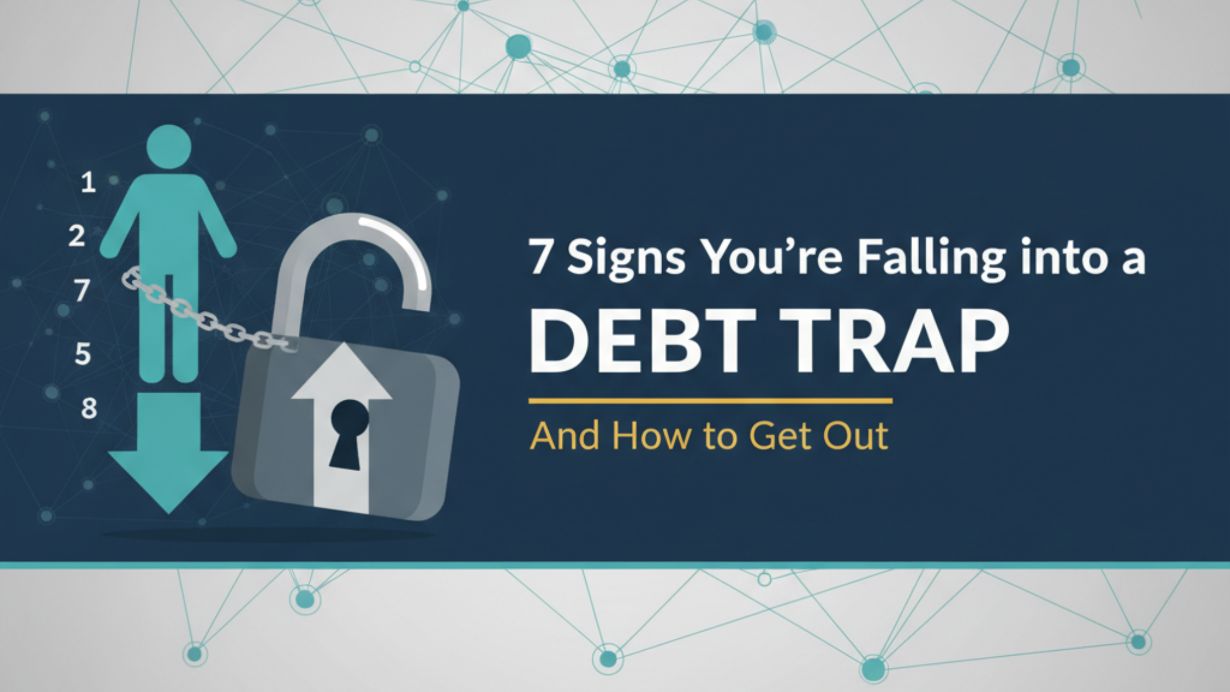· Debt Management · 4 min read
7 Signs You’re Falling into a Debt Trap and How to Get Out
Learn key signs of falling into a debt trap and practical ways to overcome it. Manage debt wisely and protect your financial future.

Falling into debt doesn’t happen overnight , it’s a gradual process that often starts with small, manageable expenses. A swipe of your credit card here, a personal loan there , and before you realize it, repayments begin to outweigh your income. This growing financial pressure is what many call a debt trap.
If you’re constantly worried about monthly payments, struggling to save, or using one loan to pay off another, it’s time to pause and assess your financial habits. Recognizing the early warning signs can help you take control before debt takes control of you.
Here are some tell-tale signs that you’re heading for a debt trap and sensible steps to get you out of it.
1. You’re Only Paying the Minimum Balance
If you’re always charging just enough to make the minimum payment on your credit card or loan, you’re not paying off your debt — you’re just keeping up with the interest. In time, this keeps the balance high and keeps you paying for a longer period of time. It’s a typical sign you’re in a debt cycle instead of paying it off.
2. You Use Loans to Pay Other Loans
Applying for one loan or credit to settle another is not a good sign. It seems like a quick solution, but really, it enhances your dependency. This practice triggers a chain that makes it difficult to account for your overall debt and even more challenging to repay it.
3. Your Monthly Expenses Are Higher Than Your Income
If your monthly bills are always more than you make, you’ll inevitably resort to borrowing to fill the gap. This disparity often means piling up credit card debt or personal loans, which can easily get out of hand.
4. You Have No Emergency Savings
Without an emergency fund, any surprise expense — medical, repair, or employment-related — will send you in the direction of borrowing. Not having savings doesn’t only hurt your fiscal stability; it raises the possibilities of going even further into debt traps whenever there’s a crisis.
5. You Should Check Your Bank or Credit Statements
Do you get nervous or tense when opening your bank or credit card statements? Avoidance is a psychological indicator that your finances might be getting worse. The problem won’t disappear if you ignore it — only debt will build up in the background.
6. You Borrow for Day-to-Day Expenses
Borrowing to pay for groceries, bills, or fuel is a sure indication that your lifestyle is not being sustained by your earnings. When credit is used as a means for survival instead of convenience, you’re probably trapped in a debt cycle that requires immediate assistance.
7. You Feel Financial Stress Constantly
Debt not only impacts your wallet but also your mental health. Constantly worrying about due dates, lender calls, or pending EMIs can affect your productivity and peace of mind. Emotional stress is often the final indicator that you’ve entered a debt trap and need to take control.
How to Get Out of a Debt Trap
It is possible to escape a debt trap with discipline and a well-planned strategy. Here are some successful strategies:
Evaluate Your Debt: Write down all your debts and interest rates to see where you are at.
Prioritize Payments: Pay off high-interest debts first while continuing to make the minimum payments on others.
Slash Inessential Expenses: Determine non-necessary expenses and apply that figure to debt repayment.
Negotiate with Lenders: Speak with your lenders regarding restructuring payments or lowering interest rates.
Seek Professional Advice: Get the help of financial experts or debt settlement professionals in establishing a repayment plan.
Build an Emergency Fund: Begin small, but try to establish a cushion that doesn’t make you take loans in case of emergencies.
Develop Better Habits: Pay with cash or debit for routine expenses and try to minimize credit card usage.
FAQs
Q1. What is a debt trap?
A debt trap happens when an individual’s debt increases quickly than their capacity to pay it off, causing repeated borrowing and financial tension.
Q2. How do I know if I’m trapped in a debt trap?
Typical signs involve paying only the minimum on each loan, using one loan to cover another, or experiencing ongoing financial stress.
Q3. Can I escape debt without borrowing another loan?
Yes. Through budgeting, eliminating unnecessary costs, and prioritized repayments, you will be able to become debt-free over time without further borrowing.
Q4. Should I opt for debt settlement or restructuring?
In case you cannot meet your repayments, you can seek debt settlement or restructuring options after considering their advantages and disadvantages with the help of a financial advisor.
Q5. How can I prevent myself from getting trapped in another debt?
Save, spend less, keep a check on your expenses, and practice good credit discipline.
Disclaimer
The information shared in this blog is for general awareness only. Every borrower’s situation may differ, and the actual process or outcome can vary based on individual circumstances.

(Expertpanel) Personal Loan Boom_ Fading Fast or Just a Pause_ (1).D1iwCU47.jpg)

 (ExpertPanel) Can Debt Impact Your Mental Health Here’s What to Do!.DMQmZTzK.jpg)